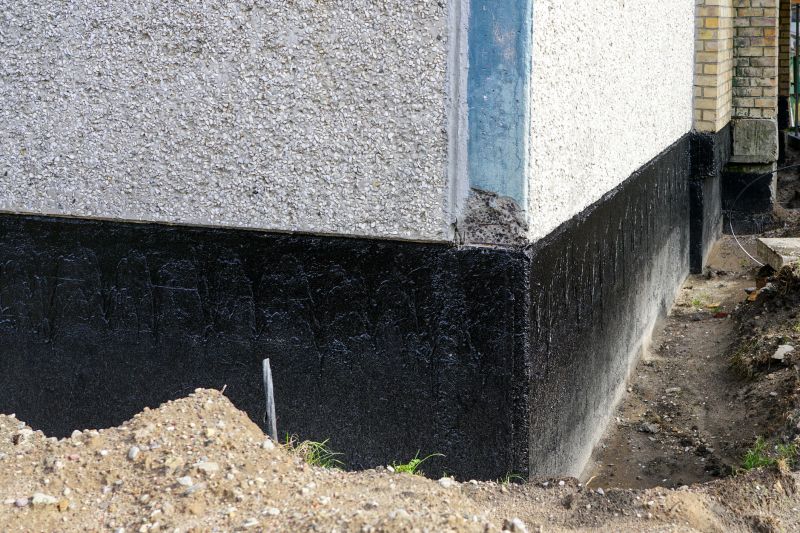Leading Waterproofing Products to Protect Your Property
Explore top waterproofing solutions designed to ensure durability and prevent water damage in various building types.
 Waterproofing products are essential solutions for protecting structures, surfaces, and materials from water infiltration and damage. They are used in various applications, including basements, roofs, foundations, and concrete surfaces, to maintain the integrity and longevity of buildings and infrastructure. Selecting the appropriate waterproofing product depends on factors such as the type of surface, environmental conditions, and the level of water exposure. Proper application and maintenance of these products can help prevent issues like leaks, mold growth, and structural deterioration.
Waterproofing products are essential solutions for protecting structures, surfaces, and materials from water infiltration and damage. They are used in various applications, including basements, roofs, foundations, and concrete surfaces, to maintain the integrity and longevity of buildings and infrastructure. Selecting the appropriate waterproofing product depends on factors such as the type of surface, environmental conditions, and the level of water exposure. Proper application and maintenance of these products can help prevent issues like leaks, mold growth, and structural deterioration.
Top Overall Option
Liquid Waterproofing Membrane
A versatile liquid membrane offers a seamless, flexible, and durable barrier suitable for a variety of surfaces. It is typically applied as a coating and can conform to complex shapes, making it ideal for roofs, foundations, and balconies. Its ease of application and ability to form a continuous protective layer make it a popular choice for many waterproofing projects.
Types of Products For Waterproofings
Liquid Waterproofing Membranes
Applied as a liquid coating, these membranes create seamless barriers on various surfaces, suitable for roofs and foundations.
Sheet Membranes
Pre-fabricated sheets made of rubber, bitumen, or plastic used for foundation and roofing applications.
Bituminous Coatings
Asphalt-based coatings that provide water resistance for roofs, basements, and bridges.
Polyurethane Sealants
Flexible sealants used to fill cracks and joints, preventing water intrusion.
Cementitious Waterproof Coatings
Waterproof coatings that can be applied directly onto masonry or concrete surfaces.
Acrylic Waterproof Coatings
Water-based coatings suitable for roofs and walls, offering UV resistance and flexibility.
Bitumen Sheets
Self-adhesive or torch-applied sheets used in roofing and foundation waterproofing.
Rubberized Coatings
Elastomeric coatings that provide flexible, waterproof layers on various surfaces.
Waterproof Paints
Paints formulated to resist water penetration, often used on exterior walls and basements.
Hydrophobic Sealants
Sealants that repel water and are used to protect joints and cracks.
Crack Fillers
Specialized products designed to fill and seal cracks in concrete and masonry surfaces.
Waterproofing Tapes
Adhesive tapes used to seal joints, seams, and cracks for quick waterproofing solutions.
Popular Choices
Often favored for their seamless application and adaptability to complex surfaces.
Widely used for roofing and foundation projects due to their durability and ease of installation.
Popular for sealing joints and cracks with flexibility and strong adhesion.
Commonly applied on exterior walls and basement surfaces for added water resistance.
Chosen for their compatibility with concrete and masonry, providing reliable protection.
Valued for their elasticity and ability to withstand movement in structures.
Effective for sealing joints and cracks in various building surfaces.
Useful for repairing and preventing water seepage through cracks in concrete.
Quick and easy solutions for sealing seams and small cracks in various surfaces.
Popular for their UV resistance and flexibility on roofs and walls.
Different types of waterproofing materials are available to suit diverse needs. Liquid waterproofing membranes, for example, are applied as coatings and form seamless barriers that can adapt to complex shapes. Sheet membranes are prefabricated and often used in foundation or roofing projects for their ease of installation and durability. Sealants and caulks are suitable for small cracks and joints, providing flexible barriers against water ingress. Additionally, waterproof paints and coatings can be applied to surfaces to add an extra layer of protection, especially in areas prone to moisture.
When choosing waterproofing products, it's important to consider the compatibility with existing surfaces, ease of application, drying or curing times, and the product's resistance to environmental factors such as UV rays, temperature fluctuations, and foot traffic. Proper surface preparation, including cleaning and priming, is crucial for optimal adhesion and performance. Regular inspections and maintenance can extend the lifespan of waterproofing solutions, ensuring ongoing protection against water damage. Consulting with professionals or thoroughly reviewing product specifications can help identify the most suitable options for specific projects and environments.
Key Buying Considerations
- Compatibility with the surface material to ensure proper adhesion.
- Type of waterproofing product suitable for the specific application (e.g., roof, foundation, crack sealing).
- Ease of application and required tools or equipment.
- Drying or curing time to plan project timelines effectively.
- Resistance to environmental factors such as UV rays, temperature changes, and foot traffic.
- Flexibility of the product to accommodate surface movement or expansion.
- Durability and expected lifespan of the waterproofing solution.
- Compatibility with existing waterproofing or building materials.
- Ease of maintenance and reapplication if needed.
- Availability of the product in appropriate sizes or quantities for your project.
- Cost considerations balanced with quality and performance.
- Safety and handling instructions during application.
- Weather conditions suitable for application to ensure proper curing.
- Environmental conditions of the area, such as moisture levels and exposure to water sources.
- Professional installation requirements or DIY suitability.
